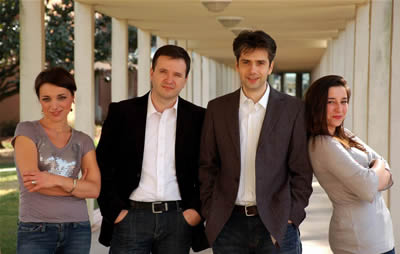Carolina Performing Arts brought performance artist Trajal Harrell to Memorial Hall, where he sowed confusion, delight and a certain amount of enlightenment on the 22nd. Harrell is best known for his elaborate series of dance works imagining a (very New York) merging of downtown post-modernism with uptown voguing. The work performed here, The Ghost of Montpellier Meets the Samurai, arises from the same impulse to investigate history and imagine alternatives, but it seemed also to have the underlying intention of dramatizing the uncertainty and flux of everything, as time rushes along on a propulsive heartbeat. A work of high conceptualism and witty humor, it is also a dance of blazing energy and intoxicating movement.
A lengthy first section set up a series of veils to be later removed and shredded. The Ghost opened with Harrell, as Anna Wintour (the editor of American Vogue, and arbiter of fashionable taste), standing up and giving a little speech about support for the arts, and telling us that we weren’t to see The Ghost, but a different piece. A lithe dancer appeared on stage in the guise of hostess for an artsy talk show; she “interviewed” dancer Thibault Lac, who appeared as Trajal Harrell, about The Ghost – telling a story, coaxing a story from him, about the (supposedly) famous meeting between the founder of Butoh, Tatsumi Hijikata, and Dominique Bagouet, an important choreographer in the 1980s French New Dance. “Two choreographers walk into a bar…” Variations on this went on for a while, until the real Trajal Harrell (still in his Anna Wintour clothes) came on stage and laid out a definitive version of this (imaginary) event.
Upstage another dancer arranged a collection of brightly colored stuff that set off a visual dissonance with the cool grays and whites of the set. During a break in the talk show, two audience members were called to the stage to pick their prizes from a raffle, before the hostess returned, all sultry-voiced, to announce the presentation of a reconstruction of the collaborative work created by Hijikata and Bagouet. In this tale, each man made a piece in the other’s style; the titles and works were known, but it was not known who made which. (Even in our imaginations we are uncertain, it seems.) Ladies and gentlemen, The Ghost of Montpellier Meets the Samurai.
Thus the dance section began. Not that the first section was dance-less, or the second section talk-free, but talk was eclipsed by pure, high-chroma kineticism. And sound. Layers of sound – different songs and pieces of music, and intermittent speech – obscuring and revealing each other in a high-energy aural wave, bone-quiveringly loud. Lighting and costumes also obscured and revealed in a number of surprising and jolting ways, creating pulsing images of the body’s beauty, only knowable a haunch or neck or ankle at a time. The dancing included a great deal of sashaying en relevé, hips forward, shoulders back, arms floating; and many fast-tempo solos with dazzling footwork; and gravity-heavy smooth twisting as in Butoh – it was all thrilling and precise. It was this precision, set against the uncertainty about what was happening, what was known or true, that made The Ghost so fascinating.
The work could be trimmed slightly (it was around an hour and a half) – some of that joke stuff goes on a little too long; there was a little self-indulgence in the length of the exquisite trio danced by three men in black dresses. But I would see Harrell and company again tonight if I could – I doubt I discerned all the layers and variations in The Ghost in one viewing. However, I’ll have to wait until July 19 to see Harrell again, when the American Dance Festival will present a section of his series, Paris is Burning at the Judson Church, in the tiny Sheafer Theater, as part of the ADF 2016 Out-of-the Box Series.











